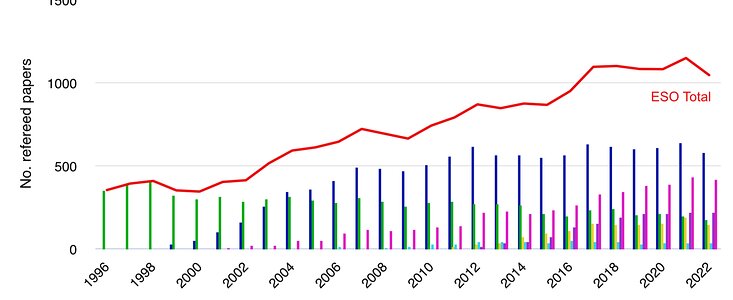Announcement
More than 1000 studies using ESO data published in 2022
10 May 2023
Observations conducted at ESO’s observatories led to more than 1000 scientific papers in 2022. Despite the fact that ESO’s observing sites were closed or operated with reduced capacity for several months during the pandemic, the number of refereed papers remained remarkably stable. A recent report by the ESO Library and Information Centre shows that this is the sixth year in a row that the number of papers has exceeded 1000.
The most significant contributions to these publications come from ESO’s Very Large Telescope (VLT) and the VLT Interferometer (VLTI) at Paranal Observatory, which led to more than 580 refereed papers. Highlights include the discovery of a new kind of stellar explosion called micronova and spying on a supermassive black hole hiding in a ring of dust. For the last three years, the Multi Unit Spectroscopic Explorer (MUSE) has been the most productive VLT instrument, a trend which has continued in 2022 with more than 160 papers.
Also located at Paranal Observatory, the Visible and Infrared Telescope for Astronomy (VISTA) and the VLT Survey Telescope (VST)[1] led to almost 150 papers. Approximately 17% of these papers used observations from both telescopes. Further south, the telescopes at ESO’s La Silla Observatory contributed to approximately 175 studies.
In 2022, the Atacama Large Millimeter/Submillimeter Array (ALMA), in which ESO is a partner, provided almost 450 papers. As in the last two years, approximately half of them (49%) used data obtained through observing time granted to astronomers based in Europe. In particular, in 2022 ALMA discovered the largest molecule yet in a planet-forming disc.
Until December 2022, ESO was also a partner of the Atacama Pathfinder Experiment (APEX)[2], located close to ALMA on the Chajnantor plateau in Chile’s Atacama region.The observations obtained partly or exclusively during ESO observing time led to a major fraction of the papers published in 2022 (63%). Among other results, APEX provided a new view of cold gas clouds in Orion’s Flame Nebula.
The number of papers that use partly or exclusively archival data has increased continuously during recent years, reaching almost 40% in 2022. In particular, 24% of papers relied on archival data alone, without any ESO observations obtained by the authors themselves. These figures demonstrate the important legacy value of the ESO Science Archive.
These impressive publication numbers highlight ESO’s important contribution to the astronomical community in its quest to advance our understanding of the Universe.
More information
The statistics presented here are derived from telbib, a database of refereed papers published by the ESO users community, developed and curated by the ESO Library and Information Centre. Whilst text-mining scripts are applied when screening the literature for ESO data papers, articles are carefully examined by the curators before they are added to the database to ensure that all telbib papers use partly or exclusively data from ESO facilities for which observing time was recommended by ESO. The public telbib interface provides visualisations of search results including on-the-fly graphs and predefined charts.
Notes
[1] The VST project was a joint venture between ESO and the Capodimonte Astronomical Observatory, part of the Italian National Institute for Astrophysics (INAF). As of 1 October 2022, this is a sole project of INAF, hosted by ESO at Paranal.
[2] As of 1 January 2023, ESO hosts and operates APEX on behalf of the Max Planck Institute for Radio Astronomy.
Links
Contacts
Uta Grothkopf
ESO Librarian
Garching bei München, Germany
Tel: +49 89 3200 6280
Email: uta.grothkopf@eso.org
Juan Carlos Muñoz Mateos
ESO Media Officer
Garching bei München, Germany
Tel: +49 89 3200 6176
Email: press@eso.org
About the Announcement
| Id: | ann23007 |

